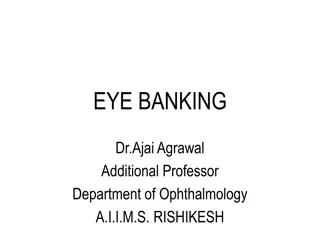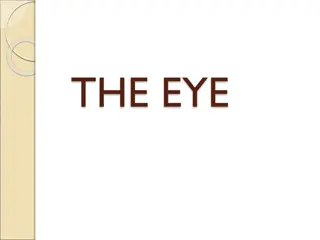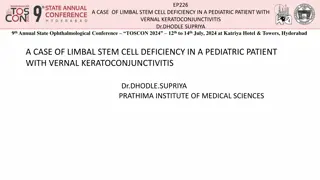Vitamin A Deficiency (Hypovitaminosis A)
Learn about the causes, symptoms, and effects of Vitamin A deficiency, including night blindness, corneal keratinization, and impaired immune function. Explore the epidemiology and pathogenesis of this condition.
0 views • 13 slides
Single-Cell Transcriptomics of TAZ-Deficient Murine Corneal Endothelium
This study explores the single-cell transcriptomics of TAZ-deficient murine corneal endothelium in the context of Fuchs Endothelial Corneal Dystrophy (FECD), a polygenic disease affecting millions globally. The research utilizes a TAZ-deficient mouse model to mimic late-onset FECD, revealing reduced
2 views • 39 slides
Global Ocular Implants Market-Projected to Reach $23.43 Billion by 2031
Ocular Implants Market Size, Share, Forecast, & Trends Analysis by Type (Scleral, Stock, Orbital, Intraocular, Retinal, Corneal) Material (Silicon, Hydroxyapatite) Application (Prosthesis, Ocuplasty, Glaucoma Surgery) End User \u2013 Global Forecast to 2031\n
1 views • 4 slides
Corneal Implants Market
The Global Corneal Implants Market size is expected to be worth around USD 902.3 Million by 2033 from USD 450.2 Million in 2022, growing at a CAGR of 7.2% during the forecast period from 2023 to 2033.\n\n
0 views • 3 slides
Innovation in Eye Care: Transforming Lives in China
Addressing the shortage of transplantable corneas in China, the project "The World Through New Eyes" aims to enable accessible and effective corneal transplant surgeries for millions of visually impaired individuals. By conducting research, building eye bank capacity, establishing a network of key o
0 views • 15 slides
Overview of Bacterial and Fungal Corneal Ulcer
Bacterial and fungal corneal ulcers, known as suppurative keratitis, are a significant cause of blindness, included in national blindness control programs. They result from infections by exogenous organisms like S. aureus, S. pneumoniae, Aspergillus, and Candida. Predisposing factors include trauma,
0 views • 28 slides
Understanding the Importance of Eye Banking
Explore the significance of eye banking, learn about the history, surgical procedures, and key milestones in the field. Understand the need for eye banks in preserving vision, treating diseases, and supporting corneal transplants. Discover how early intervention can prevent devastating eye injuries.
0 views • 56 slides
Understanding the Complexity of Human Anatomy in Cardiovascular Health
Explore the intricate organization of human tissues within arteries and veins, and uncover the vital roles they play in maintaining cardiovascular function. Learn about specific tissues such as collagen, muscle, and endothelium, and their significance in preventing diseases and regulating blood flow
0 views • 50 slides
Understanding Eye Health: From Anatomy to Treatment of Common Eye Conditions
Explore the anatomy of the eye, learn about common eye diseases like corneal laceration and cataracts, and understand their treatments. Discover the impact of cataracts on global blindness and the surgical options available for restoring vision. Follow a martial arts athlete's journey through cornea
0 views • 13 slides
Clinical Evaluation of Trigeminal Nerve Function
Sensory evaluation of trigeminal nerve function involves assessing exteroceptive sensations across its divisions, identifying sensory losses due to lesions, and distinguishing different types of lesions affecting sensation on the face. Motor evaluation focuses on the muscles of mastication to detect
0 views • 34 slides
Understanding Myopia: Causes, Treatment, and Management
Myopia, also known as nearsightedness, is a common visual condition that affects a significant portion of the Canadian population. It is typically caused by elongated eyeballs or excessive corneal curvature, leading to blurry distance vision. While glasses or contact lenses can correct myopia optica
0 views • 15 slides
Impact of Pupil Dilation on Biometric Measurements in Cataract Patients
Cataract surgery requires precise intraocular lens power calculation for optimal refractive outcomes. This study explored the effects of pupil dilation on biometric measurements (such as axial length, corneal power, anterior chamber depth, lens thickness) and IOL power calculation using SS-OCT based
0 views • 7 slides
Diverse Ailments Resulting in Corneal Melt - Ophthalmological Conference Highlights
The presentation by Dr. Adipudi Ramya at the 9th Annual State Ophthalmological Conference highlighted various ailments leading to corneal melt, including clinical signs, causes such as chemical injuries and fungal lesions, and treatment approaches. The research focused on patients with pain, redness
0 views • 6 slides
Photorefractive Keratectomy in Thin Myopic Eyes: Outcomes Study at TOSCON 2024
Evaluation of photorefractive keratectomy (PRK) in thin myopic eyes at the 9th Annual State Ophthalmological Conference (TOSCON) 2024. The study aims to assess visual acuity, safety, efficacy, structural, and functional outcomes of PRK in patients with myopia and corneal thickness <500um. Key object
0 views • 6 slides
Understanding Ametropia: Refractive Eye Conditions Explained
Ametropia refers to refractive errors in the eye such as myopia, hypermetropia, and astigmatism, where light rays don't focus correctly on the retina. This condition is influenced by corneal power, anterior chamber depth, crystalline lens power, and axial length. Hypermetropia, also known as hyperop
0 views • 25 slides
Managing Ocular Cicatricial Pemphigoid: A Case Study from TOSCON 2024
A 64-year-old female presented with ocular symptoms, diagnosed with Ocular Cicatricial Pemphigoid at the 9th Annual State Ophthalmological Conference (TOSCON) 2024. Treatment included topical lubricants, anti-inflammatory agents, immunomodulators, and mini-scleral lens fitting. The patient showed sy
0 views • 6 slides
Comparative Analysis of Cataract Surgery Techniques
The study compared safety and efficacy of terminal chop, stop and chop, and direct chop techniques in cataract surgery. Results showed terminal chop had advantages in terms of corneal thickness, endothelial cell loss, and cumulative dissipative energy. Terminal chop demonstrated improvement compared
0 views • 6 slides
Eye Conditions Overview in Primary Healthcare Guidelines
This document provides information on common eye conditions such as corneal ulcers and eye injuries/foreign bodies, presenting symptoms, and reasons for their inclusion in primary healthcare guidelines. It emphasizes the importance of early detection and management of these conditions to prevent com
0 views • 5 slides
Case Study: Limbal Stem Cell Deficiency in Pediatric Patient with Vernal Keratoconjunctivitis
Limbal stem cell deficiency (LSCD) is a rare condition characterized by inadequate corneal rejuvenation and conjunctivalization of the cornea. In this case study, a 14-year-old male with Vernal Keratoconjunctivitis presented with itching, eye rubbing, and corneal epithelial scarring resembling a who
0 views • 6 slides
The Anatomy of Horses and Domestic Ruminants
Horses possess a unique stay apparatus that allows them to stand for long periods with minimal muscular activity, while domestic ruminants like cows, sheep, and goats have osseous horns that grow continuously. The stay apparatus in horses consists of ligaments and tendons stabilizing their joints, e
0 views • 6 slides



















